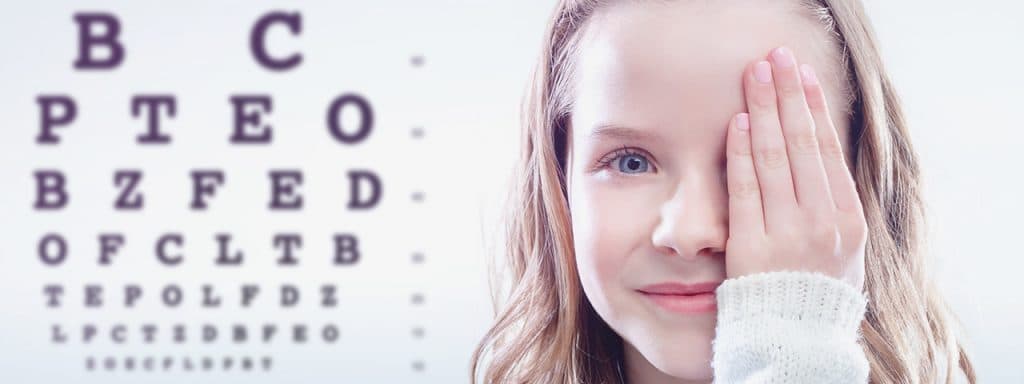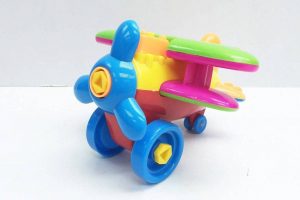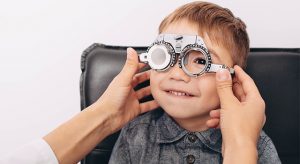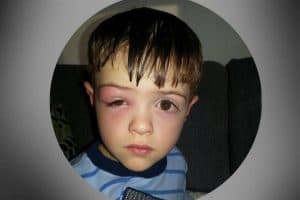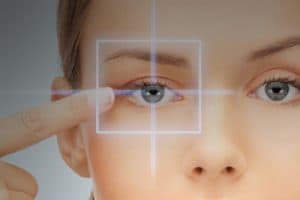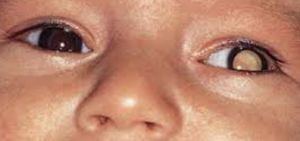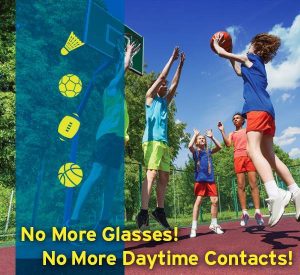Myopia, also known as nearsightedness or shortsightedness, causes distant objects to appear blurry or out of focus.
Myopia affects clarity of vision for any distant image— the board in a classroom, the television, a clock on the wall, etc.
- Myopia affects millions of children and adults, worldwide.
- Over 30% of the U.S. population suffers from myopia.
Moreover, the global demographics show that this condition affects up to:
- 6% by age 6
- 15% by age 9
- 25% by age 13
- 40% by age 17
Myopia is often hereditary, and typically begins in childhood, after the age of four, when the eyes begin to grow rapidly. This condition tends to worsen as the child approaches the teenage years, and typically plateaus by the age of 20.
Myopia occurs when the eye grows too long (axial length), or the cornea and/or eye lens are too curved relative to the length of the eyeball.
A myopic eye focuses an image at the front of the retina, instead of directly on the retina, causing blurry distant vision. Myopia can be corrected using corrective eyeglasses or contact lenses and is noted on the eye doctor’s optical prescription by a negative sign, such as -1.00 or -2.25.
Signs of myopia
- Blurry distance vision
- Squinting when reading the board or watching TV
- Sitting at close proximity to the TV or computer screen
- Sitting at the front of the classroom to clearly see the teacher and board
- Holding books close to the eyes
- Disinterest in playing sports that require clear distance vision
- Reduced clarity of vision, as compared to friends and family
If your child shows any of these signs above contact an eye doctor near you to evaluate your child’s vision and visual skills.
SEE RELATED: Why Is My Child’s Myopia Worsening?
Can myopia cause serious eye problems?
Yes.
In most cases, low levels of myopia, generally below -3.00, present little risk, if any, to your child’s ocular health. These lower levels of myopia present more of an inconvenience than a health risk, as a child needs to get used to wearing glasses or contact lenses to see clearly.
However, in about 10 percent of people with myopia, the condition worsens in severity. Sometimes myopia can worsen to the point that it is considered a degenerative disorder, which can cause significant or total loss of vision.
Myopia is a serious condition that can increase the risk of developing ocular diseases later in life, such as cataracts, glaucoma, or retinal detachment.
The myopia explosion
Over the past 20 years, the number of children globally with myopia has exploded.
Consider these facts:
- In Asia, up to 90% of children are now myopic.
- In the USA, the number of children with myopia will increase from 39 million in 2020 to over 45 million by 2050.
The good news is that with regular eye exams, vision therapy, and myopia management, your child can regain clear vision, while lowering their risk of developing an ocular disease from myopia.
Is it possible to prevent myopia from worsening?
Yes.
Myopia increases as the size (axial length) of the child’s eye increases. As increasing myopia leads to an increased risk of serious eye conditions, there are now specifically trained optometrists in the field of Myopia Management that can provide effective treatments.
Research has shown that certain lifestyle habits can influence myopia progression— highlighting the importance to keep certain factors under control. For instance, the amount of time we spend in front of the screen has increased considerably over the years.
Televisions, computers, cellphones, and other digital devices can have damaging effects on our eyes. It is important to follow certain rules that can help to reduce these effects:
- Set time limits of usage per day
- Take frequent breaks, at least every hour
- Place your screen 18-24 inches away
- Adjust screen brightness and contrast to make it more comfortable
- Avoid screen use where a glare can affect vision
- Blink frequently
Practice the 20-20-20 rule— every 20 minutes, look 20 feet away, for 20 seconds. This rule applies for any near vision activity that requires prolonged focus (reading, writing, texting, etc.)
Can playing outdoors help?
Yes.
Slowing the progression of myopia has also been associated with spending time outdoors. Outdoor play should be part of your child’s daily routine—doctors recommend 60-80 minutes per day!
Spending time outdoors allows natural light to enter the eye and gives the eye muscles a chance to relax and focus on distant objects, while encouraging healthy lifestyle habits.
How is myopia treated?
Children with myopia have several options available to regain clear distance vision, including:
- Eyeglasses. For most children with myopia, eyeglasses are the most common choice. A child with a high distance prescription will need to wear glasses all of the time. A child with a lower prescription may only need their glasses for specific activities that require distance vision such as watching TV, or playing sports. It is important to know that for some children, the myopia is due to the stress of near-vision. These children might be prescribed a bifocal or progressive (multi-focal) lens.
- Contact lenses. Contact lenses provide clear vision at all distances, with a wider field of view, as compared to eyeglasses. Many children prefer to wear contacts when playing sports or attending social events. However, contact lenses are placed directly on the eyes, and therefore require proper hygiene to maintain eye health.
- Orthokeratology (ortho-k). Ortho-k involves the use of specialized rigid contact lenses that reshape the cornea, the front outer surface of the eye. The contacts work to flatten the cornea, thereby changing the way light is focused on the retina at the back of the eye.
- Laser procedures. Laser procedures such as LASIK (laser in situ keratomileusis) or PRK (photorefractive keratectomy) are generally recommended for patients over the age of 20, mainly because the eye generally stops growing by this age. A laser procedure can provide clear vision by permanently removing corneal tissue to improve the eye’s focusing abilities.
- Vision therapy. Some children develop myopia as a result of weak visual skills—required for reading, school work, and computer or smartphone use. Vision therapy involves a personalized program that trains the child’s visual system, including the eye-brain connection, to work more efficiently— thereby improving focusing abilities.
Contact a vision therapy eye doctor near you to start treating your child’s myopia management program.
Myopia management
A growing field in optometry is Myopia Management.
This new field is based on a number of recent research studies and years of clinical trials that suggest that it may be possible to control myopia by slowing its progression during childhood and teenage years. Controlling myopia progression can include a number of different treatment methods— orthokeratology, multifocal glasses or contact lenses, and eye drops.
Your doctor will discuss with you which treatment method is most appropriate for your child.
Don’t wait…schedule an eye exam
If your child has myopia, schedule an eye exam with an eye doctor as soon as possible.
Myopia is reaching epidemic numbers around the world. Undetected myopia can cause many complications for a child— academic, social, and emotional problems.
LEARN MORE: Guide to Pediatric Eye Conditions
A comprehensive eye exam will enable your doctor to detect the causes of your child’s myopia. Myopia Management might slow down or even stop the myopia from worsening – protecting your child from serious eye diseases later in life.

